Key Takeaways
- ChatGPT makes your data tasks easier by automating repetitive steps like data cleaning and exploratory analysis, helping you work more efficiently;
- Setting up ChatGPT for data analysis involves preparing your data and leveraging AI tools alongside your expertise for optimal results;
- Be aware of ChatGPT's limitations, such as handling complex datasets and potential biases, and always verify the results for accuracy.
Ace quick missions & earn crypto rewards while gaining real-world Web3 skills. Participate Now! 🔥
If you are into data analysis, you’ve probably heard about how AI tools transform the field. ChatGPT is one such tool, making waves for its ability to simplify data analysis. The buzz around ChatGPT data analysis tools is substantial - it promises to make your tasks more efficient. Businesses leverage AI applications like Writesonic and Synthesia to streamline workflows and optimize resources. Why wouldn't you?
As with most tools, ChatGPT must be tested first to see if it lives up to the hype or is just another overpromised tech solution. It may seem daunting, but I will walk you through the essentials to ensure you can quickly use ChatGPT for data analysis.
We'll start with the basics: what ChatGPT is and how it works in the context of data analysis. From there, I’ll cover practical steps for setting it up, preparing your data, cleaning it, and performing exploratory analysis. By the end of this tutorial, you'll know the answer to "Can ChatGPT do data analysis?" and whether it is a good fit for your data projects. It’s a great opportunity to learn how to use ChatGPT for data analysis and transform your daily workflow.
Table of Contents
- 1. Setting Up ChatGPT Data Analysis Tool
- 2. Preparing Your Data
- 3. Using ChatGPT for Data Cleaning
- 4. Exploratory Data Analysis with ChatGPT
- 4.1. Generating Summary Statistics
- 4.2. Visualizations and Trend Identification
- 4.3. Interactive Feedback
- 5. Statistical Analysis with ChatGPT
- 5.1. Running Tests and Interpreting Results
- 5.2. Hypothesis Testing and Practical Uses
- 6. Advanced-Data Visualization with ChatGPT
- 7. Best Practices and Limitations
- 7.1. Best Practices
- 7.2. Limitations
- 8. Conclusions
Setting Up ChatGPT Data Analysis Tool
ChatGPT is a language model developed by OpenAI. It's designed to understand and generate human-like text based on the input it receives. While it can be used for various applications, data analysis with ChatGPT is one of its growing uses. However, AI can help you with more than just data analysis. For instance, you can utilize tools like Fireflies to generate video transcriptions or Murf for high-quality voiceovers.
Latest Writesonic Coupon Found:To use the ChatGPT data analysis plugin, you need access to the platform first. This can be achieved through OpenAI’s website or other platforms that support ChatGPT integration. Depending on your usage, you'll need to create an account and might require API access. Once you have access, you can interact with ChatGPT via a web interface or API calls in your preferred programming environment.
Before diving into analysis, you must prepare your data. ChatGPT data analysis plugin effectively transforms raw data into analyzable forms, suggests ways to handle missing values, and even generates code snippets for everyday tasks[1]. You can describe your dataset and ask for recommendations on proceeding.

Once your data is ready, ChatGPT can help with various analysis tasks. You can ask it to perform statistical tests, generate visualizations, or provide insights based on the data. For example, you can input your dataset and ask ChatGPT to identify trends or outliers. It can also assist in creating reports by drafting narratives that explain your findings.
Combine its capabilities with your expertise to get the most out of ChatGPT. While AI can handle many tasks, your domain knowledge will ensure accurate results. Use the ChatGPT data analysis plugin to automate repetitive tasks, freeing your time for more complex analyses requiring human intuition and experience.
By the end of this tutorial, I hope you’ll be well on integrating ChatGPT into your data analysis workflow. To make things even more interesting, try asking AI itself, "How to use ChatGPT for data analysis?" and compare the answer with what you learned from me.
Preparing Your Data
Before starting ChatGPT data analysis, it's essential to have your data well-prepared. Properly preparing the information involves three main steps: data collection, cleaning, and formatting.
The first step is gathering the information you need. Identify the sources of your data. These sources could include databases, spreadsheets, APIs, or web scraping. Ensure you have all necessary permissions to access and use this data, especially if it involves sensitive information.
Keep your sources organized to make the next steps smoother. To achieve that, you can ask ChatGPT something like: "How can I use APIs to collect real-time data for my analysis?" or "What are the best practices for organizing data from multiple sources?".
Raw data is often messy and needs to be cleaned before analysis. This step involves removing duplicates, correcting errors, and handling missing values.
Start by inspecting your dataset to identify apparent errors or inconsistencies. Remove duplicate entries that could skew your analysis. Address missing values: decide whether to remove them, replace them with standard values, or use advanced techniques like imputation.
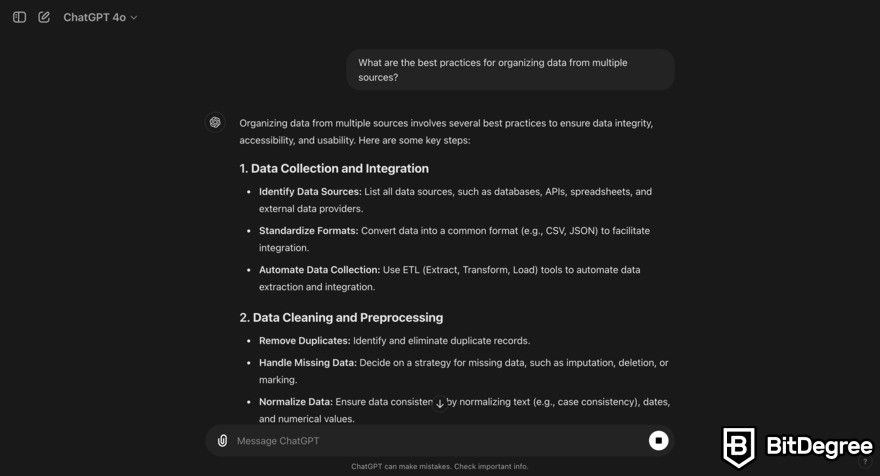
Check for outliers that might distort your results. While some outliers are legitimate data points, others could be errors. Evaluate them case by case. Consistently apply the same cleaning rules across your collected information to maintain data integrity. To make this happen, try such a prompt: "How do I identify and remove duplicate entries in my dataset using Python?" or "What are the best methods for handling missing values in a dataset?".
Formatting data correctly is essential for compatibility with analysis tools. Ensure your data types (e.g., integers, floats, and strings) are appropriate for each column. Consistent formatting helps in efficient data processing and reduces errors during analysis.
Organize your information into a tidy format where each column represents a variable, and each row represents an observation. This structure is crucial for practical analysis with tools like ChatGPT.
If your dataset is large, consider breaking it into smaller, manageable chunks. Vast amounts of information can slow down processing times and make it harder to identify issues. Using scripts or automated tools to handle repetitive formatting tasks saves time and reduces human error. Here are some prompts to ease things out for you:
- "What is the best way to format a dataset for analysis in Python?";
- "How can I efficiently convert data types in a large CSV file?";
- "Can you generate a script to split a large dataset into smaller chunks for easier processing?".
By following these steps, you'll have a well-prepared dataset ready for analysis with ChatGPT. Proper data preparation ensures more accurate, reliable, and insightful results from your AI-driven analysis.
Using ChatGPT for Data Cleaning
Data cleaning is a crucial part of the whole process. It involves identifying and correcting errors in your dataset to ensure the accuracy and reliability of your analysis. ChatGPT can assist with this task by spotting missing values, highlighting inconsistencies, and suggesting corrections.
To begin, upload your dataset and ask the AI to identify missing values since it can impact the results of your analysis. Therefore, it's essential to address these gaps. ChatGPT can scan your dataset, pinpointing where values are missing. It can then recommend methods to handle gaps, such as mean imputation, where missing values are replaced with the mean of the available data, or forward fill, where missing values are filled with the last observed value.
For instance, you might start the chat like this, "I have a dataset with missing values. Can you help me identify them and suggest ways to handle them?".
Once the missing values are addressed, it's time to look for inconsistencies. It can include data that doesn't conform to expected formats or values outside a reasonable range. For instance, you might have a column that should only contain dates, but some entries are text. ChatGPT can help spot these issues and suggest corrections. A prompt like this should work, "Can you check for inconsistencies in my dataset?".
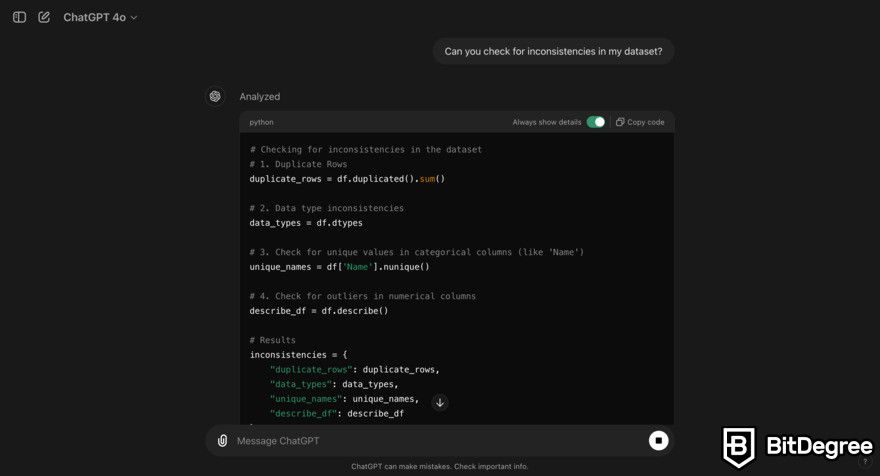
Beyond identifying missing values and inconsistencies, ChatGPT can also assist in removing duplicates. These entries can skew your analysis and lead to incorrect conclusions. Asking ChatGPT to find and remove duplicates ensures each data point is unique. "My dataset might have duplicate entries. Can you find and remove them?".
Data analysis with ChatGPT capabilities extends to suggesting data transformations. Sometimes, raw data needs to be transformed to be helpful. This can include normalizing numerical data, encoding categorical variables, or creating new features from existing data. ChatGPT can recommend appropriate transformations if you explain your data and analysis goals. "I need to normalize my numerical data and encode categorical variables. Can you help?".
In summary, using the ChatGPT data analysis tool for data cleaning involves a series of interactive steps: upload a dataset, ask questions, and receive recommendations. This process saves time and helps ensure your data is clean and ready for analysis. By leveraging ChatGPT, you can efficiently tackle the often tedious task of data cleaning and move on to deeper analysis.
Exploratory Data Analysis with ChatGPT
Exploratory Data Analysis (EDA) is another significant step in data analysis. It involves summarizing and visualizing the main characteristics of a dataset to uncover patterns, spot anomalies, and check assumptions. Data analysis with ChatGPT lets you generate statistics, create visualizations, and efficiently identify trends or anomalies.
Generating Summary Statistics
To start EDA, generate summary statistics that describe the central tendency, dispersion, and shape of your information's distribution. Using ChatGPT for data analysis, you can quickly obtain these statistics by inputting your dataset and asking for specific measures.
For instance, you can request ChatGPT to calculate your dataset's mean, median, mode, standard deviation, and range. Ask it, "Can you provide summary statistics for my dataset?".
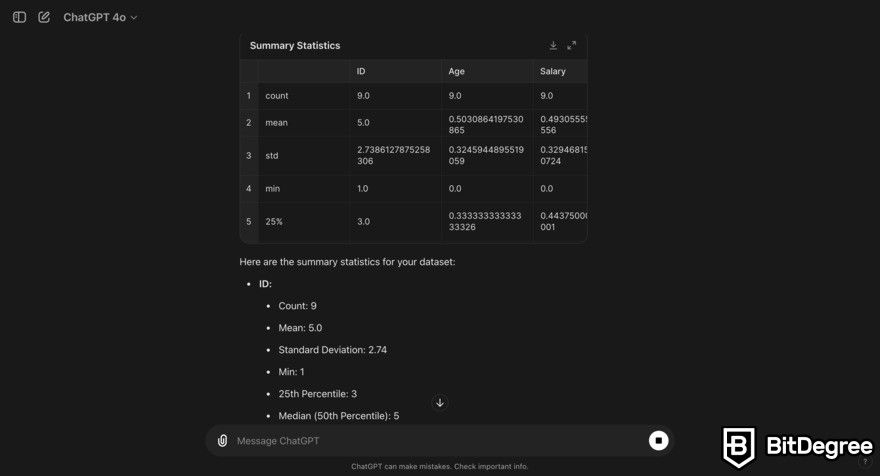
This interaction saves time and ensures a solid understanding of your data's basic properties before you dive deeper into the analysis.
Visualizations and Trend Identification
Visualizations are a powerful tool in EDA, enabling you to see patterns and relationships that might not be apparent from raw data alone. ChatGPT can help generate various visualizations, such as histograms, box plots, scatter plots, and bar charts.
For example, if you want to visualize the distribution of a variable, you can ask ChatGPT to "Create a histogram of the 'age' column in my dataset.".
You can also use scatter plots to explore relationships between two variables, "Generate a scatter plot of 'age' vs. 'income'.".
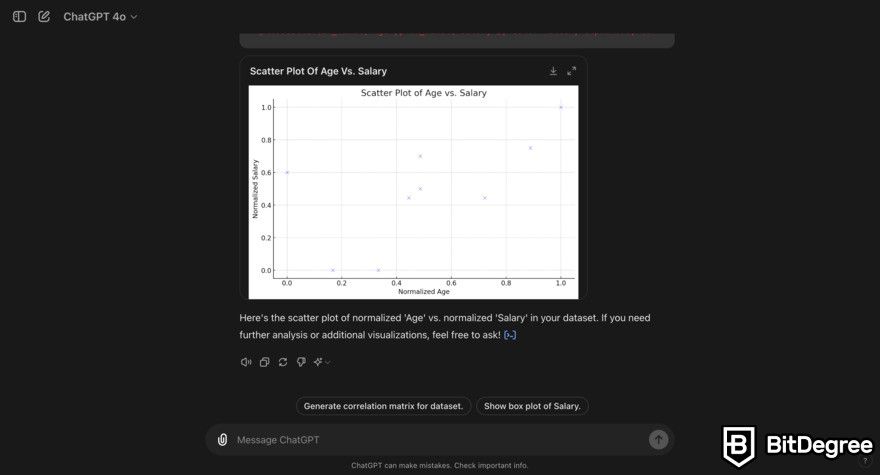
These visualizations help you quickly grasp your data's structure and relationships and improve your analysis and decision-making skills. AI tools like Synthesia and Pictory are excellent for creating engaging video content based on your data insights to make your presentations more dynamic.
Spotting trends and anomalies is a crucial aspect of EDA. Trends indicate patterns that repeat over time or across different subsets of your data, while anomalies are data points that deviate significantly from the norm. ChatGPT can assist in identifying both.
For trend analysis, you might ask, "Can you help me identify any trends in my sales data over the past year?".
For anomaly detection, you can query, "Are there any anomalies in my temperature readings dataset?".
These insights are invaluable for understanding your data's behavior and making data-driven decisions.
Interactive Feedback
One of ChatGPT's strengths is its ability to provide real-time feedback. You can iteratively explore your data by asking follow-up questions based on initial findings. This dynamic approach allows you to dive deeper into areas of interest without switching tools or writing extensive code.
If you notice an anomaly in your scatter plot, you might ask, "What could be causing the anomaly in the 'age' vs. 'income' scatter plot?".
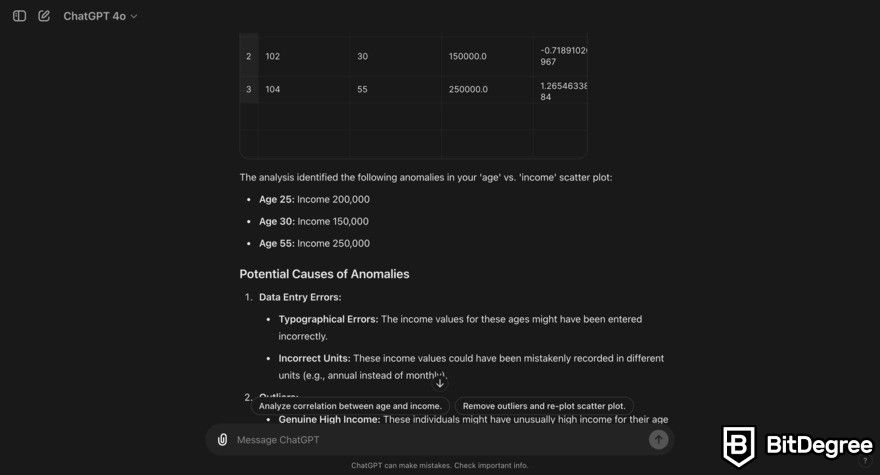
In conclusion, EDA with ChatGPT simplifies summarizing and visualizing data, making it easier to identify trends and anomalies. By leveraging AI’s capabilities, you can perform a thorough exploratory analysis that lays the foundation for more advanced data analysis with ChatGPT tasks.
Statistical Analysis with ChatGPT
Statistical analysis is a core aspect of data analytics, enabling you to make data-driven decisions. ChatGPT data analysis capabilities can assist in performing various statistical tests and interpreting the results, making it a valuable tool for analysts.
Running Tests and Interpreting Results
To perform statistical tests with ChatGPT, you must first upload your dataset in a supported format such as CSV or Excel. ChatGPT can handle a range of statistical analyses, including t-tests, chi-square tests, ANOVA, and regression analysis. The ChatGPT data analysis plugin will understand your needs and generate the code to execute these tests.
If you want to compare the means of two groups, you could ask, "Perform a t-test to compare the means of Group A and Group B in this dataset.".
ChatGPT will write and execute the code and provide the results, including p-values and confidence intervals, indicating whether the difference between the groups is statistically significant.

Understanding the output of statistical tests is crucial. ChatGPT can help explain the results. For instance, if you perform a regression analysis, ChatGPT data analysis can provide insights into the coefficients, R-squared values, and p-values, helping you understand the relationship between variables.
Consider asking to "Explain the results of this linear regression analysis.".
ChatGPT will detail each coefficient's representation, the model's goodness of fit (R-squared), and the predictors' significance (p-values).
Hypothesis Testing and Practical Uses
ChatGPT data analysis tool can also assist with hypothesis testing by guiding you through setting up null and alternative hypotheses, choosing the appropriate test, and interpreting the results. For example: "I want to test if there is a significant difference in customer satisfaction before and after a service improvement. Which test should I use?".

Based on the data structure and the nature of your hypothesis, ChatGPT might suggest a paired t-test and provide the code to conduct it.
For practical applications, you can leverage ChatGPT for:
- Market research: Conducting t-tests to compare consumer preferences across different demographics.
- Healthcare analysis: Using chi-square tests to examine the association between treatment and outcomes.
- Financial modeling: Performing regression analysis to predict stock prices based on historical data.
By integrating ChatGPT into your statistical analysis workflow, you can automate complex calculations and focus more on interpreting and acting on the results. Always combine the insights provided by ChatGPT with your knowledge to ensure the most accurate and meaningful conclusions.
Advanced-Data Visualization with ChatGPT
As I showed before, visualizing data helps to understand and communicate insights effectively. The ChatGPT data analysis tool can generate various visualizations for advanced users or even provide a base code to work on them individually.
Using ChatGPT for data analysis and creating visualizations involves a few simple steps. First, describe your data and the visualization you want. For example, if you have sales data and want to see the distribution, you can ask ChatGPT to create a histogram, "I have sales data for the past year. Can you create a histogram to show the distribution of monthly sales?".
Once the data is provided, ChatGPT can generate the code to create the visual. This often involves using Python libraries like matplotlib or seaborn. ChatGPT will write and guide you through executing the code in your environment. To create a code for a histogram, you might say: "Generate a code of histogram for the sales data.".
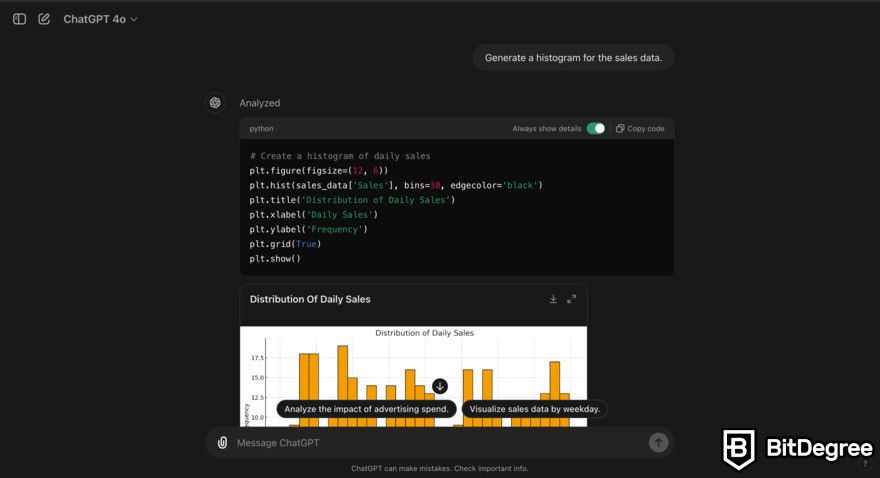
You can run this code locally in your Python environment to see the histogram and make changes easily.
Scatter plots are ideal for visualizing relationships between variables. For instance, if you have advertising spend and sales data, you can visualize how they relate. "Create a scatter plot to show the relationship between advertising spend and sales.".
This plot will help you see if there is a correlation between the two variables.
Bar charts are excellent for comparing different categories. They are appropriate for comparing sales across various regions. "Create a bar chart to compare sales across regions.".
This bar chart will help you compare the sales performance among four regions.
ChatGPT data analysis can also help you customize your visualizations by adding titles and labels and adjusting colors. Customizations enhance the clarity and visual appeal of your charts. "Can you modify the scatter plot to include a trend line?".
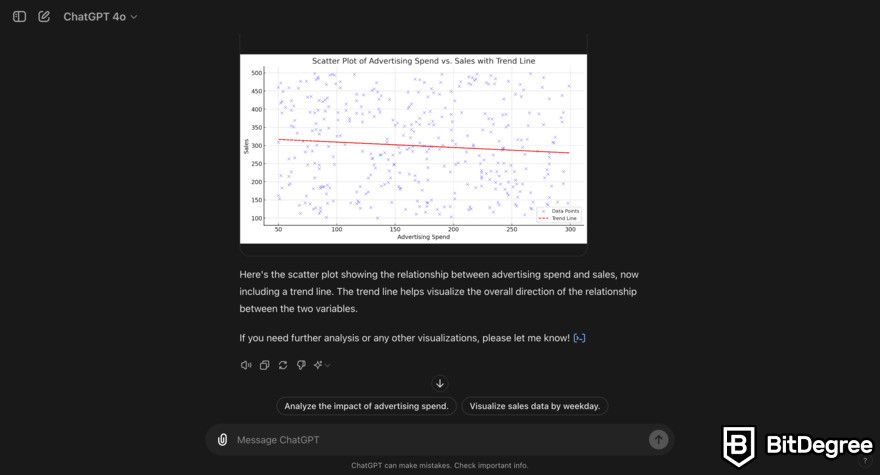
The added trend line to your scatter plot makes it easier to see the overall trend.
ChatGPT data analysis simplifies the creation of various data visualizations. You can receive customized code to generate charts by describing your data and the desired visualization. These visualizations are crucial for interpreting data and communicating findings effectively.
Best Practices and Limitations
ChatGPT data analysis tool can significantly enhance productivity by simplifying data tasks and providing valuable assistance in the data analysis process[2]. Here are some best practices and limitations to keep in mind.
Best Practices
Write clear and concise prompts. Specific instructions help ChatGPT generate more accurate and relevant responses. For example, rather than asking, "Analyze my sales data", specify, "Identify trends in monthly sales over the past year.".
Clean and preprocess your data before using the application to analyze your information. This includes handling values, removing duplicates, and ensuring consistent formatting. Properly prepared data improves the quality of the analysis ChatGPT can provide.
Use an iterative approach when working with ChatGPT; treat it like your teammate. Start with broad questions and gradually narrow down to more specific queries based on the insights you receive. This helps in refining the analysis and ensuring comprehensive coverage of your data.

While the software can handle many analytical tasks, your domain knowledge is required to interpret the results accurately. Use ChatGPT data analysis to automate repetitive tasks and generate insights, but rely on your expertise to validate and contextualize these findings.
Always be mindful of ethical concerns, especially about data privacy and bias. Ensure your data complies with privacy regulations and the outputs are critically evaluated for potential biases.
Maintain strong security practices. Anonymize sensitive data and use secure channels for communication and data storage. Restrict access to the AI model and its outputs to authorized personnel only.

- Free to use
- Add-ons for Microsoft Word and Chrome
- Wide selection of tools
- Extensions for Chrome and Edge browsers
- Some tools are free
- Easy to use

- Supports over 120 voices in 20 languages
- Live customer support
- Voice cloning feature
- Voice cloning
- Emphasis and pauses
- Background music

- Easy to use
- AI-powered tools
- Cross-platform integration
- Multitrack editing
- AI-powered editing
- Accurate transcription
Limitations
ChatGPT may struggle with large or complex datasets, leading to slower processing or incomplete analysis. In these cases, consider breaking the data into smaller chunks or using specialized data processing tools alongside the AI.
The model may not always produce accurate or consistent results, especially with highly technical language. Always verify the outputs with additional sources or through manual checks to ensure reliability.
In addition, the quality of the analysis heavily depends on how the prompts have been written. Ambiguous or poorly structured descriptions can lead to irrelevant or incorrect responses. Investing time in crafting precise questions is crucial for practical use.

ChatGPT might miss the context or nuances of the data, leading to misinterpretation. It's essential to give background information and interpret the results within a broader context.
The model can reflect biases present in its training data. Be aware of these limitations and take steps to mitigate their impact by critically evaluating the generated insights. By following these best practices and being mindful of the limitations, you can effectively integrate data analysis with ChatGPT into the workflow.

Did you know?
Have you ever wondered which online learning platforms are the best for your career?
Conclusions
I thoroughly covered everything related to the question, "Can ChatGPT do data analysis?". The ChatGPT data analysis tool can automate repetitive tasks and assist with data cleaning, visualization, and statistical analysis. It also explains complex concepts, making it useful for both novices and experts. Its ability to support interactive data exploration through follow-up questions further enhances its utility.
However, it can struggle with technical language, leading to potential inaccuracies. Inconsistent outputs and privacy concerns when handling sensitive data are significant limitations. Biases from training data can also affect results.
To mitigate these issues, provide clear prompts and verify outputs. Use ChatGPT as a supplementary tool and combine its insights with your expertise to ensure high-quality analysis. Also, remember to explore other AI tools like Quilbot and Synthesia to further enhance your data projects. Combining them with ChatGPT will provide the best results.
The content published on this website is not aimed to give any kind of financial, investment, trading, or any other form of advice. BitDegree.org does not endorse or suggest you to buy or use any kind of AI tool. Before making financial investment decisions, do consult your financial advisor.
Scientific References
1. R. Lingo: 'The Role of ChatGPT in Democratizing Data Science: an Exploration of AI-facilitated Data Analysis in Telematics';
2. D. Gruda: 'Three Ways ChatGPT Helps Me in My Academic Writing'.


.jpg?tr=w-400)







